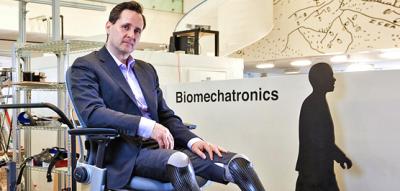Robert Langer
Targeted anti-cancer drugs
Winner of the European Inventor Award 2016
Approved for clinical use in 1996, Robert Langer's ingenious method relies on a class of drugs known to inhibit the process of "angiogenesis", which is the formation of new blood vessels feeding cancerous tumours. As angiogenesis inhibitors lose their efficacy when injected into the blood stream, Langer took a different approach. He coated the drugs with wafer-shaped "bio plastics", implanted at the actual tumour site, ensuring the drugs release their payload with maximum impact.
Langer achieved his breakthrough by developing biologically tolerable polymers into building blocks that can be shaped into capsules for drug delivery, into cardiovascular stents or even into support structures for growing new body tissue.
Societal benefit
The brain cancer known as glioblastoma multiforme (GBM) is the most common and aggressive cancer of the primary central nervous system, with a median survival rate of only 15 months. According to the National Cancer Institute, 22 850 adults in the US were diagnosed with brain or other nervous system cancers in 2015, and 15 320 of these diagnoses resulted in death. Particularly difficult to treat due its proximity to healthy tissue, GBM accounts for 52% of all primary brain tumours.
Approved for the treatment of glioblastoma in 1996, Langer's targeted drug delivery system has greatly improved outcomes in clinical practice: Patients achieved a survival rate of 63% in clinical trials, compared with 19% in the control group. To date, over 20 million patients worldwide have been treated with angiogenesis-inhibiting substances, and therapies derived from Langer's bioplastics, including drug-coated cardiovascular stents, have benefited more than one million.
Economic benefit
Marketed under the drug name Gliadel to treat GBM, Langer's invention generated sales of around EUR 32.5 million (USD 35.8 million) in 2006 for drug company Eisai, which divested rights to the technology in 2012 to the US-based Arbor Pharmaceuticals. Langer's inventions jumpstarted a new class of treatments for prostate cancers, endometriosis, and mental illnesses with considerable market success: The bioplastics-encapsulated drug Zeneca Zoladex (prostate cancer) netted around EUR 905 million in 2013, and Risperdal Consta (schizophrenia) EUR 1.4 billion in 2014.
An advocate of bridging the gap between research and the marketplace, Langer leads the world's largest biomedical engineering lab with over USD 10 million in annual grants and over 100 researchers. The GBM treatment market - including the Langer-designed drug Gliadel - is poised to grow from about EUR 273 million (USD 301 million) in 2013 to EUR 566 million (USD 623 million) by 2020, at a compound annual growth rate (CAGR) of 10.9% (GBI Research).
How it works
While angiogenesis inhibitors have been used since 1971, their efficacy declines radically when injected or orally ingested. Langer's invention relies on encapsulating the drugs with biologically tolerable polymers in the shape of wafers, which are implanted directly at the site of the tumour. After slowly releasing the drugs, the biologically tolerable polymers are broken down and excreted via the body's metabolism.
Langer's method of direct implantation solves two problems: First of all, the drugs are placed beyond the blood-brain barrier - which would otherwise block their entry - for slow and targeted release, thereby guaranteeing maximum efficacy. Secondly, the powerful drugs can have neurotoxic effects - harming healthy brain tissue - if delivered in an untargeted manner. The invention solves this by focusing the drug's effect on the site of the tumour.
The inventor
Langer first began his concept of implantable bioplastics technology as a young researcher at MIT's Department of Chemical Engineering, but he would spend almost 28 more years perfecting it, experimenting with over 200 variations of polymers in the first two years alone. Putting his breakthrough into practice, Langer founded more than 20 biotech companies, including MicroCHIPS and Transform Pharmaceuticals.
During his prolific biochemical research career spanning over 40 years, Langer has authored over 13 000 articles and was named the most-cited engineer in history by Science Magazine (h-index score: 222 as of 9 March 2015). Currently the David H. Koch Institute Professor in the Department of Biochemistry at MIT, he has contributed to 1 060 patents, with inventions licensed by 300 pharmaceutical companies.
For his achievements in chemical engineering, Langer has received 220 awards, including the Charles Stark Draper Prize (2002), Queen Elizabeth Prize for Engineering (2015), and the US National Medal of Science (2006) and Medal of Technology and Innovation (2011), a feat he shares with just three other living individuals.
Did you know?
Bioplastics dissolve without a trace after serving their purpose, giving them a major advantage over conventional plastics, which represent a growing burden on the environment. According to the World Economic Forum, the world's oceans now contain 150 million tonnes of plastic. By 2050, there will be more plastic in the sea than fish.
With global plastic production poised to double over the next 20 years, some manufacturers are taking notes from the bioplastics playbook. A wave of "green" plastics, mostly for packaging, is hitting the market, but these are subject to strict regulations: European Norm EN 13432 stipulates that truly "green" plastics must degrade by 90% within a maximum of six months.
Media gallery
Contact
European Inventor Award and Young Inventors Prize queries:
european-inventor@epo.org Subscribe to the European Inventor Award newsletterMedia-related queries:
Contact our Press team#InventorAward #YoungInventors










